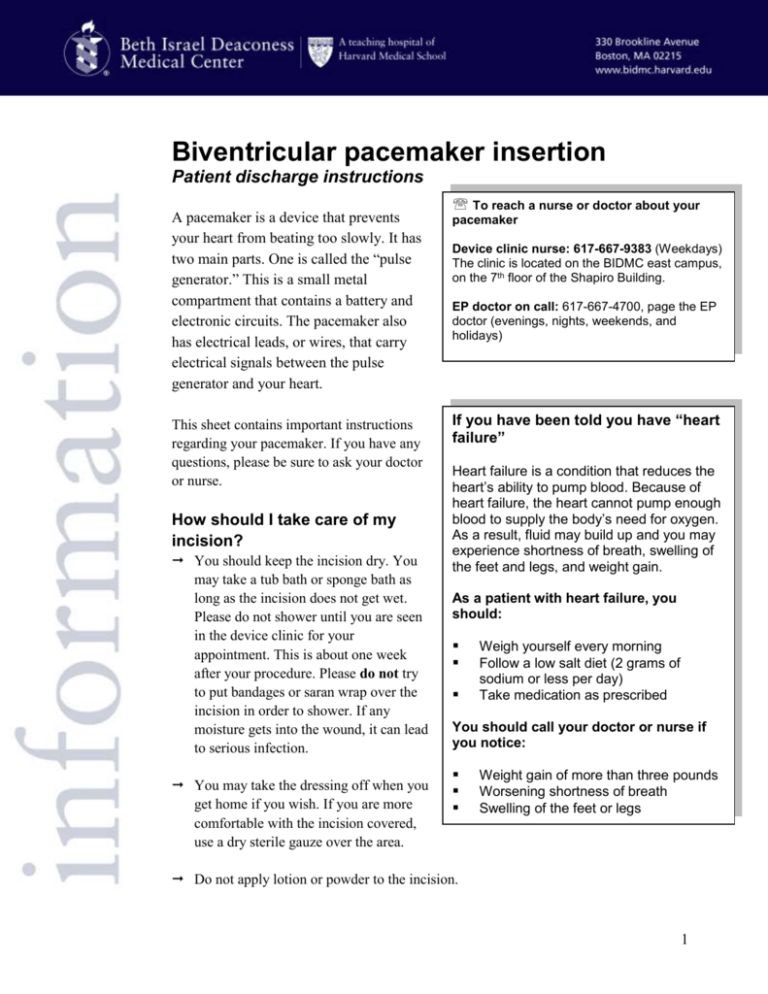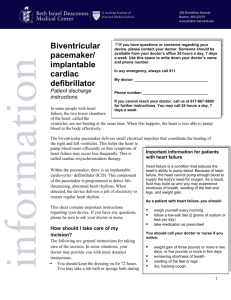
Biventricular pacemaker insertion
Patient discharge instructions
A pacemaker is a device that prevents
your heart from beating too slowly. It has
two main parts. One is called the “pulse
generator.” This is a small metal
compartment that contains a battery and
electronic circuits. The pacemaker also
has electrical leads, or wires, that carry
electrical signals between the pulse
generator and your heart.
This sheet contains important instructions
regarding your pacemaker. If you have any
questions, please be sure to ask your doctor
or nurse.
How should I take care of my
incision?
You should keep the incision dry. You
may take a tub bath or sponge bath as
long as the incision does not get wet.
Please do not shower until you are seen
in the device clinic for your
appointment. This is about one week
after your procedure. Please do not try
to put bandages or saran wrap over the
incision in order to shower. If any
moisture gets into the wound, it can lead
to serious infection.
You may take the dressing off when you
get home if you wish. If you are more
comfortable with the incision covered,
use a dry sterile gauze over the area.
To reach a nurse or doctor about your
pacemaker
Device clinic nurse: 617-667-9383 (Weekdays)
The clinic is located on the BIDMC east campus,
on the 7th floor of the Shapiro Building.
EP doctor on call: 617-667-4700, page the EP
doctor (evenings, nights, weekends, and
holidays)
If you have been told you have “heart
failure”
Heart failure is a condition that reduces the
heart’s ability to pump blood. Because of
heart failure, the heart cannot pump enough
blood to supply the body’s need for oxygen.
As a result, fluid may build up and you may
experience shortness of breath, swelling of
the feet and legs, and weight gain.
As a patient with heart failure, you
should:
Weigh yourself every morning
Follow a low salt diet (2 grams of
sodium or less per day)
Take medication as prescribed
You should call your doctor or nurse if
you notice:
Weight gain of more than three pounds
Worsening shortness of breath
Swelling of the feet or legs
Do not apply lotion or powder to the incision.
1
You might have slight itching at the incision. Try not to scratch the incision or rub it.
You may see small paper strips across the incision. Please allow these to fall off on
their own. (This may take several weeks.)
Let someone in the device clinic (617-667-9383 ) know right away if there are signs
of infection to the area, including:
redness
swelling
drainage
fever – temperature of 101 or more
pain that is getting worse instead of better
any opening in the skin at the site of device
If needed, you may take acetaminophen (Tylenol) every six hours as needed for
discomfort. (Never take more than 4 grams, or 4,000 milligrams, of Tylenol in 24
hours.) If your discomfort is severe or is not relieved by Tylenol please call us.
May I go back to my usual activities?
Please follow these guidelines regarding activity. Ask questions about any other
activities you aren’t sure about.
You may be asked not to drive for a certain amount of time during your recovery.
This is different for everyone. Please ask your doctor when you may drive.
During the first six-eight weeks, you will need to watch how you use the arm on the
side where your pacemaker was inserted. Do not raise the arm above the height of
your shoulder. You may not swim or play tennis or golf. You may wash your face,
brush your teeth, shave, and comb your hair as usual. This is a good time to ask for
help with things like raking leaves, cleaning, painting, ironing, vacuuming, or
walking a dog.
For six weeks, don’t lift or carry anything weighing more than five pounds. You may
receive additional instructions regarding not pulling or pushing things with the arm
on the side of your pacemaker for a period of time. Please ask if this applies to you.
What medicines should I take?
Before you leave the hospital, you will be given a list of all the medicines you
should take once you are at home. Please be sure to ask any questions you have
about medications. If something you normally take is not on the list, please
ask whether you should continue taking it. This includes prescription
2
medicines, nonprescription medicines, vitamins, herbs, and supplements.
You may be given a prescription for antibiotics to take for a short time when you get
home.
If you are on warfarin (Coumadin), you are likely to need a blood test within five
days of discharge. Please ask if you do not know when your next blood test should
be.
Use of electronic and other equipment
Because of your pacemaker, you should never have an MRI (magnetic resonance
imaging) to any part of your body. MRI is a special test that uses a magnet to look
inside the body. Exposure to the MRI magnet can ruin the pacemaker, causing it to
malfunction.
Arc welding is also not allowed.
You may use a microwave oven. You may use cell phones, remote controls, and
other electronic devices, but these must be held at least one foot from the pacemaker.
Please do not walk through security gates at airports. Show your ID card to the
security personnel and go around the gate. Although unlikely, the gate could cause
your device to malfunction.
Do not allow security personnel to put a scanning wand within one foot of your
device. It is ok for them to use the wand on your body, but it needs to stay one foot
away from where your pacemaker is implanted.
Other important information
You will receive a pacemaker identification card in the coming weeks. You should
carry it with you at all times.
You should also carry a list of your medications, a brief summary of your medical
history, a list of any allergies, and your doctors’ phone numbers.
Be sure to always tell any doctor, dentist, or other health care provider who treats
you that you have a pacemaker.
You may wish to purchase a medical identification bracelet or necklace that informs
anyone caring for you that you have a pacemaker.
Over
3
How can I reach a nurse or doctor if I have a question?
On weekdays, a nurse at the pacemaker/device clinic is available to answer your
questions. The phone number appears on the front of this sheet. You may also call your
own EP (electrophysiology) doctor. On evenings, nights, weekends, and holidays, you
may call the EP physician on call.
Follow-up appointments
Prior to your discharge home, you will be given information about your follow-up
appointments. Be sure to ask any questions you may have about your appointments.
Call for help if:
As noted above, call for help if you have:
redness, swelling, drainage, or any opening at the area of your incision
temperature of 101 or more
pain from the incision that is getting worse instead of better
swelling of the feet or legs
weight gain of more than three pounds
worsening shortness of breath
a return of symptoms you had before your pacemaker insertion or any other symptom
that concerns you
Note: You underwent a procedure performed under fluoroscopic (x-ray) guidance. Procedures
involving lengthy exposures to x-rays may cause damage to the skin and/or hair. These adverse effects
may be increased if one has had previous (especially recent) radiation exposure to the same skin area.
Radiation injury to the skin can take many forms, including an area of redness, blistering, hair loss, or
ulceration. These effects may appear after a few weeks or even after several months. If any of these
occur on the side and back of torso (or elsewhere), please contact the interventional cardiology
section at 617-632-7455 to arrange further evaluation.
This material was prepared by clinicians from the department of cardiology at Beth Israel Deaconess Medical Center. It is
produced and distributed by The Beth Israel Deaconess Learning Center. ©2007, Beth Israel Deaconess Medical Center. All
rights reserved.
MC1640 11/07
4










